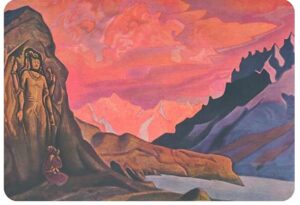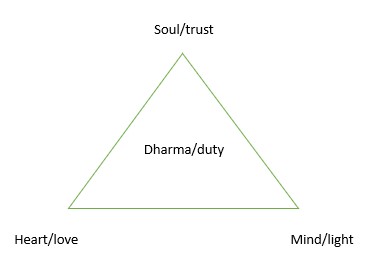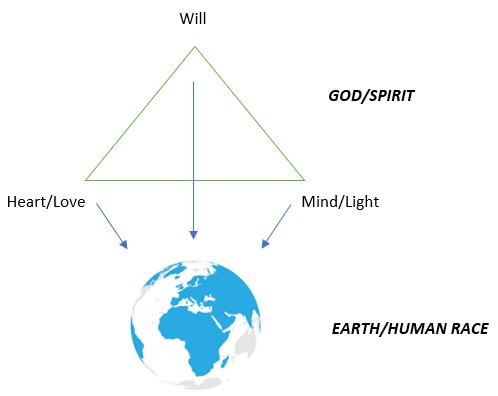How to Use the Great Invocation

Nicholas Roerich
E.P. Hafstein
Invocations and Mantras
Using the Great invocation
Conclusion
References
In his work, Master D.K.[1] invites groups of aspirants and disciples who are both able and willing to use the Great Invocation correctly. They must be prepared to undergo training for this purpose. This transformative tool, he says, has the power to bring a group of people into being on the physical plane who can, in the course of their daily lives, combine their forces with those of the Hierarchy so that the Great Invocation, with its supreme effect, will be put to its proper use.
Invocations and Mantras
Mantras and invocations, including the Great Invocation, are effective only when used on the mental plane with the mind’s force concentrated on their content and meaning. This intense concentration supports the spoken word and is crucial for producing the desired effect. However, their impact is enormous when they are also spoken with the force of the soul.
For years, aspirants worldwide have used the sacred word OM. This user effect is seen in the disciples’ small-scale awakening of creative imagination and spiritual longing. However, this use has primarily impacted the students’ auras rather than their surroundings, which is the intention. Nevertheless, the sacred word OM is immensely potent and has a wide-ranging effect when used correctly. In such cases, its use results in two outcomes. Firstly, it dispels undesirable and coarse matter from all personality bodies. Secondly, it acts as an attractive force, drawing more refined material into the body to replace what is dispelled.
If this is true regarding the sacred word OM, it also applies to the Great Invocation. All mantras, including the sacred word OM, originate from the second ray. It is the ray of consciousness and, therefore, the ray of the soul or the expression of the second aspect of Deity. Only the soul, with its potent will, can use mantras and OM, producing the desired result, which, without exception, aligns with the Divine Plan. It is generally forgotten, and the role of divine will is usually overlooked. The Great Invocation, the sacred word OM, and all mantras must come from the soul, emphasizing its potent will and role in creating a unified thought form from living, illuminated thought material. In this way, the Will, Love/Wisdom, and Active Intelligence of the person who uses them will be activated.
All too frequently, however, the process breaks down. What happens is that the individual generates a thought form of the process in his mental body and nothing more. It is because the brain cannot perform the dual work on which the whole process is based. It is necessary to keep the thought forms stable and reflect the meaning behind the mantras and invocations. Simultaneously, one must send forth their content, embedded in the words and the sound. This dual working must be performed simultaneously by the soul, on its plane, and through the personality’s mental body and brain.
Using the Great invocation
When using the Great Invocation, we must keep two things in mind. First, the student (the personality) must consciously connect with the powers of the soul. Second, the dual working described above must be activated, meaning we need to keep the thought forms of the Great Invocation stable while simultaneously sending forth their content embedded in the words.
The following description exemplifies the Great Invocation used by a disciple following the above rules. The process is divided into two stages.
The first stage, contacting the soul: The disciple adopts a specific position for meditation, calms his physical body, and brings the emotional body into a state of equilibrium. Consequently, the mental body is fully awake and ready for the cognitive work ahead. Next, the disciple makes contact with the forces of the soul through the Disciple’s Invocation, which runs as follows:
The Disciple's Invocation
My pathway is laid out before me.
I keep light in my mind and love in my heart;
a soul am I, soaring on wings to the heights.
The Disciple’s Invocation draws attention to four points that the disciple must keep clear: The disciple is an incarnate soul and must be entirely governed by this awareness. The disciple knows that the soul lays down the pathway before the physical body is created. This is his duty in life or his “dharma.” Only love is present in the emotional body. Complete peace reigns in the mental body, illuminated by spiritual light. It can be represented as a triangle:

When the Disciple’s Invocation is employed, dual working characterizes the mental function, i.e., reciting the Disciple’s Invocation and simultaneously picturing the graphic form above. It is sufficient to contact the forces of the soul because the soul, on its plane, will see to all other internal connections.
The second stage involves the disciple using the Great Invocation to create a clear thought form that embodies the Invocation’s content and meaning. Throughout the recitation, the disciple visualizes it as an entity. Graphically, it takes the following form:

The Great Invocation (adapted version)
From the point of Light within the Mind of God
Let light stream forth into human minds.
Let Light descend on Earth.
Light flows from the Mind of God to human minds, illuminating their dwelling place – the physical plane.
From the point of Love within the Heart of God
Let love stream forth into human hearts.
May the Coming One return to Earth.
Love flows from the Heart of God to human hearts. Love represents higher human consciousness (the soul consciousness). Simultaneously, this part of the Invocation is a direct call to the World Teacher to reappear on Earth and stimulate evolution.
From the center where the Will of God is known
Let purpose guide all little human wills –
The purpose which the Masters know and serve.
In Shambala, a spiritual concept associated with the center of God’s will, God’s purpose is known. This purpose must serve as humanity’s guiding light, akin to the guiding light and the will of the Masters. Understanding and aligning with the purpose of Shambala is essential for the Great Invocation practice.
From the center, which we call the human race
Let the Plan of Love and Light work out
And may it seal the door where evil dwells.
When love and light reign in people’s hearts and minds, negative mental and emotional currents cannot form.
Let Light and Love and Power restore the Plan on Earth.
The human entity achieves unity when the personality is entirely controlled by the soul’s will and reflects only love and spirituality (light). It can then bring God’s Plan, or its small part of the Plan, down to the physical plane.
As the disciple recites each verse of the Great Invocation, he keeps the above thought form in mind. It is essential to continually maintain the thought form and meaning of each verse in his mind as he recites the Great Invocation. This must be done throughout the entire recitation of the Invocation. In this way, the disciple performs the dual working of the soul with the mind and brain as intermediaries.
Conclusion
If only the millions of people who currently use the Great Invocation realized the effects and changes in the direction of progress it produces when used correctly, they would be more willing to undergo training to utilize it properly. Among the effects could be:
- A complete change in humanity’s state of consciousness.
- The standardization of humanity as a spiritual being.
- The restructuring of the thought forms humans have created led to the disorder on Earth that history bears witness to.
- Opening the door to the New Age for a better culture and lifestyle.
These changes would occur so quickly that they would feel almost miraculous. The horrors and sordidness of the present would become relics of the past. Humanity would enter an age of goodwill, benevolence toward all individuals, and correct interpersonal relationships.
References
1 Bailey, A.A.1989: The Externalisation of the Hierarchy. London: Lucis Trust. 4th edition (1st edition 1957).